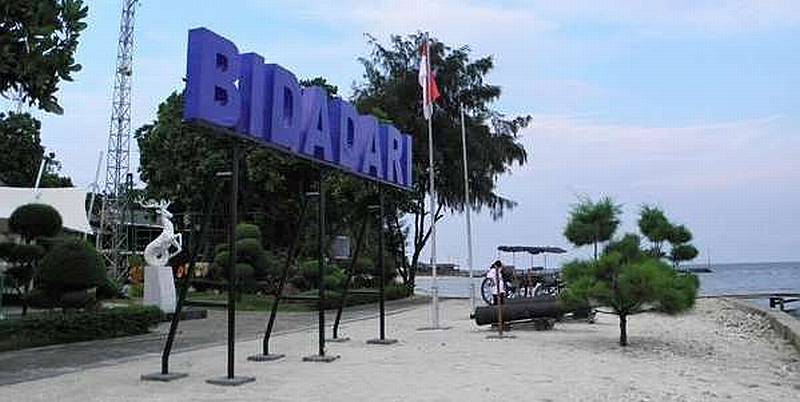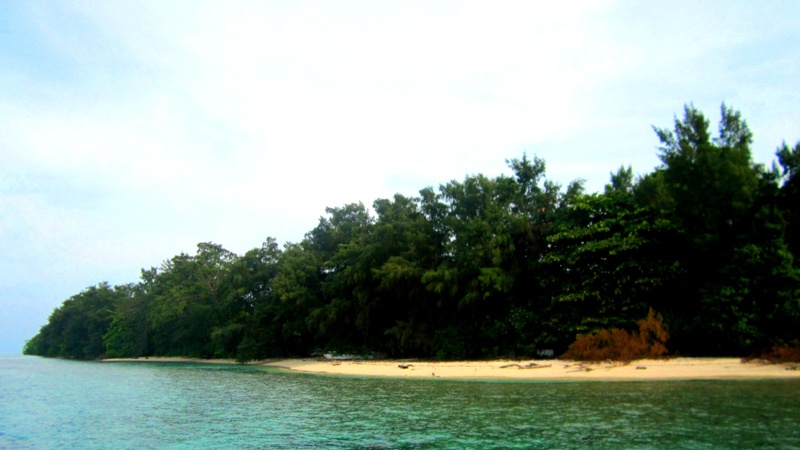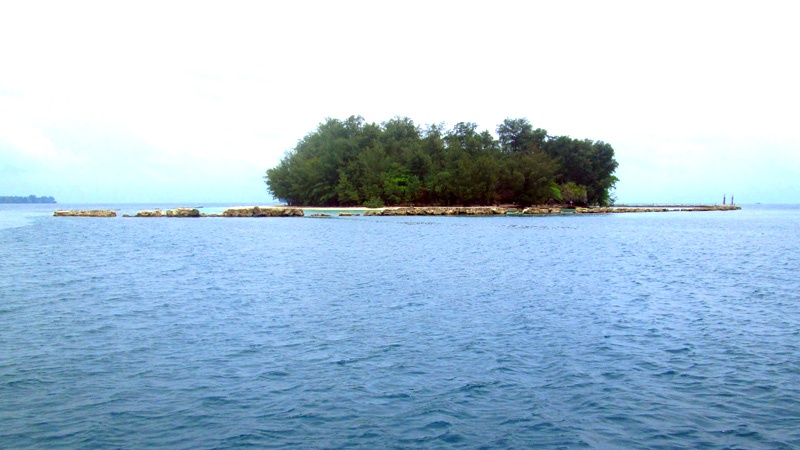The Thousand Islands are the natural water and beach playgrounds for Jakarta citizens. The islands each offer different types of recreation from just beach combing, boating, jet skiing and snorkeling, to fishing and scuba diving further out to sea. A number of islands such as Pulau Ayer, Pulau Pramuka, Pulau Kotok and Pulau Putri have bungalows for rent complete with facilities to enjoy island life at your leisure.
To make your holiday complete, here are also Dutch colonial vestiges to explore in archaeological parks as well as nature reserves for breeding of hawksbill turtles and protection of mangrove forests. Several types of flora and fauna frequently found in the Thousand Islands include coral reefs, starfish, sand starfish, Betok fish (Anabas Testudineus Bloch) and ornamental fish such as the Sargent Major fish among others.
Regular boats leave Marina Ancol to the various islands at 8.0 am and 9.0 am, returning around 1.0 pm or 2.0 pm. Speedboats are also special departures to the tourist resorts.
Pulau Pramuka is known for its conservation and breeding site of hawksbill turtles and the protection of mangrove forests. Visitors are invited to feed and release hatchlings to the sea. There is also a butterfly reserve where you can watch the many species of colorful butterflies grow from cocoon to transforming themselves into beautiful butterflies.
Around Pulau Pramuka are crystal clear waters that are great for snorkeling and diving. The seafloor around here is flat, so underwater photographers love to take macro-photos of the wonderful creatures living in these seas. You can also feed sharks which are well protected in shark cages. Reachable within 2 to 2.5 hours by boat from Marina Ancol or Muara Angke, Pulau Pramuka has also a "floating" restaurant to enjoy your meals at sunset.
Pulau Putri has cottages facing the sea, facilities for diving, glass bottom boats and even an undersea aquarium. It also offers sunset cruises.
At Pulau Sepa you can try a marine walk, where visitors can walk along the bottom of the sea to enjoy the underwater marine life and feed the fish without having to dive. Here you can go snorkeling, scuba diving, jetski, fishing, canoeing and lots more.
While Pulau Pantara is built for groups. It has 90 cottages and facilities including meeting room and outbound facilities. The islands are around 2.5 hours by luxury speedboat from Ancol Marina.
To make your holiday complete, here are also Dutch colonial vestiges to explore in archaeological parks as well as nature reserves for breeding of hawksbill turtles and protection of mangrove forests. Several types of flora and fauna frequently found in the Thousand Islands include coral reefs, starfish, sand starfish, Betok fish (Anabas Testudineus Bloch) and ornamental fish such as the Sargent Major fish among others.
Regular boats leave Marina Ancol to the various islands at 8.0 am and 9.0 am, returning around 1.0 pm or 2.0 pm. Speedboats are also special departures to the tourist resorts.
The Paradiso Islands of Pulau Ayer, Bidadari and Untung Jawa
Islands nearest and within a half an hour reach from Jakarta's Marina in Ancol are the islands of Bidadari, Ayer and Untung Jawa. These are recreation resorts, that come complete with cottages and water sports facilities such as banana boats, jet skis and more. On Pulau Ayer are cottages that ''float'' on the sea with interior decorations of exotic Asmat textiles and sculptures.Pulau Onrust
And while you are island hopping, visit Onrust, which is a heritage and archaeological park. In 1613 Onrust island used to be a shipyard for Dutch vessels, and later became Batavia's defense against foreign invaders. Today one can still see remnants of the fortress called the Martello Bastion at Pulau Kelor.Pulau Pramuka
At Pulau Pramuka, situated in the center of the Thousand Islands, is where you will find the office of the head of Kepulauan Seribu district government. Therefore, Pulau Pramuka has the largest population and the best amenities, complete with schools, mosque and other facilities including internet connections.Pulau Pramuka is known for its conservation and breeding site of hawksbill turtles and the protection of mangrove forests. Visitors are invited to feed and release hatchlings to the sea. There is also a butterfly reserve where you can watch the many species of colorful butterflies grow from cocoon to transforming themselves into beautiful butterflies.
Around Pulau Pramuka are crystal clear waters that are great for snorkeling and diving. The seafloor around here is flat, so underwater photographers love to take macro-photos of the wonderful creatures living in these seas. You can also feed sharks which are well protected in shark cages. Reachable within 2 to 2.5 hours by boat from Marina Ancol or Muara Angke, Pulau Pramuka has also a "floating" restaurant to enjoy your meals at sunset.
Pulau Tidung
One of the largest islands in the Kepulauan Seribu archipelago, Pulau Tidung offers captivating panoramic views across the sea. Most favorite spot is the Bridge of Love that connects the Large Tidung with the Small Tidung island. This bridge is where young lovers pledge their vows to love each other ever after while romantically watching the sun slowly disappear on the horizon under an orange sky.Pulau Putri, Pulau Sepa and Pulau Pantara
These are among the furthest out into the Java Sea, and for this reason waters surrounding the islands are still crystal clear with colorful coral reefs teeming with fish, and are ideal for diving and fishing.Pulau Putri has cottages facing the sea, facilities for diving, glass bottom boats and even an undersea aquarium. It also offers sunset cruises.
At Pulau Sepa you can try a marine walk, where visitors can walk along the bottom of the sea to enjoy the underwater marine life and feed the fish without having to dive. Here you can go snorkeling, scuba diving, jetski, fishing, canoeing and lots more.
While Pulau Pantara is built for groups. It has 90 cottages and facilities including meeting room and outbound facilities. The islands are around 2.5 hours by luxury speedboat from Ancol Marina.

Kelor, Kahyangan, and Damar were also used by the Dutch. These 3 islands also have historic VOC maritime links.
Bidadari island (Heavenly Nymphs island), it was a fort and a lepers hospital, and now its been turned into a resort with bungalows and restaurants. The Dutch Governor - General Camphuis was one of the earliest residents of Jakarta to appreciate these islands. In 1685, he constructed a Japanese-style villa on Damar Island amidst gardens stocked with rare animals and vegetation.

Kotok and Gosonglaga Island offer many diving possibilities with wooden shipwrecks and excellent coral cover.
Transportation here varies from fisherman motorboats, inter-islands shuttles, to large cabin cruisers. The nearest islands are just 10 minutes from the shore. You can find international standard accommodations on the islands of Putri, Pelangi, Sepa, Pantara, Matahari, and Kotok which sits on the westernmost tip and has the best coral growth.
Dive Sites
Peniki Island
This is an oblong island oriented along a northsouth axis. A few people live here. There is an interesting reef off the western side of Peniki. The reef starts at 5 meters, and its best coral growth at around 20 meters. At the southwest point is the wreck of a 20-meters wooden cargo ship. Schools of barracuda, batfish, large parrotfish and moray eels have made the wreck their home. Here you may also find a particular number of anemones and anemone fish.


Papa Theo Island
Formerly called Pulau Tondan Timur Island, this island was renamed when the Papa Theo, a cargo vessel, sank on the reef here in 1982. The vessel about 20 meters long now rests with its port side facing the reef. It is a simple wreck dive with lots of marine life and occasional shark in the deeper waters at the stern end. There are parrots, some resident groupers, many morays and a particular abundance of stingrays. The north reefs is often chosen for night dives.


China Cemetery
This small island is one of the best diving sites in Thousands Islands. The good reef begins due west of the island and there is a small bit of reef at the north tip. Excellent coral growth provides the backdrop for a good drift dive in 8-20 meters depth. Low tide exposes a wide expanse of reef flat, and at high tide; the island shrinks dramatically with only a sand bank showing.


Melinjo Island
This island provides a very good reef extend from the west around to the north, and along the south of the island. The best diving is at 8-12 meters where you can find lobsters up to 30 centimeters long. The reef is also home to a great numbar of moray eels.


Kotok Island
This island sits on the western edge of the Thousands Islands groups and thus offers an undamaged reef for snorkeling as well as diving. Kotok Island is the best in the island for snorkeling and off-the beach diving. The west, north and east part are good at 20 meters depth. This island faces the open sea, thus make it the best place to see schools of sweetlips, turtles and sharks. Small manta rays have been seen here. The area is abundant in gorgonians and soft corals.


Similarly, information about the best diving sites in Thousand Island. Snorkeling and diving is the right thing if you want to see the location of underwater paradise that is located here. Hopefully this article can serve as a reference for the tourists who will plan dives in Thousand Island, Java.
Image Source: Google Image
Image Source: Google Image
